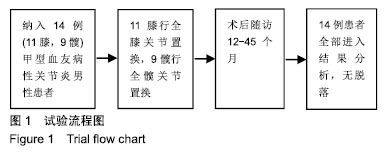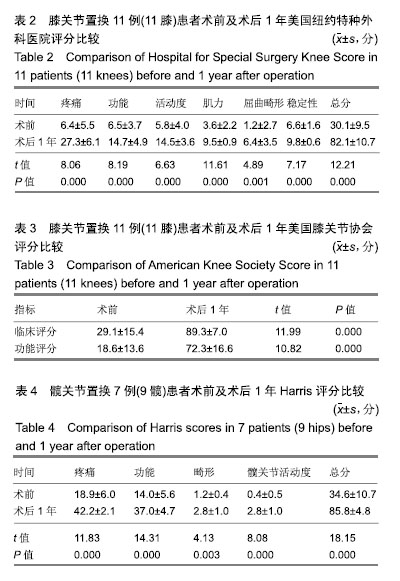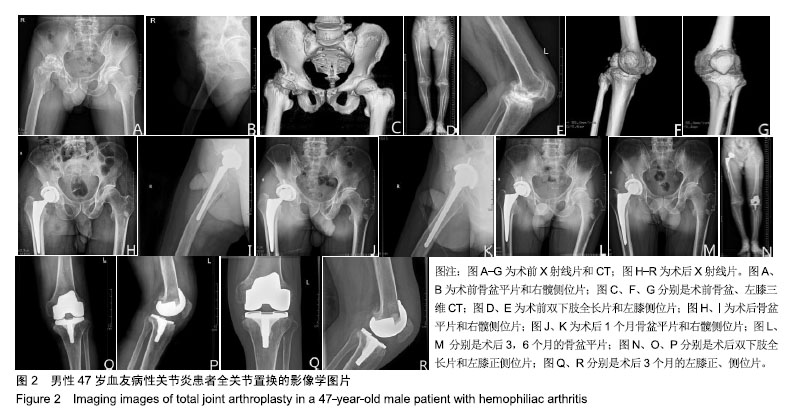| [1]Badulescu OV, Tudor R, Friedl W, et al. Efficiency of tranexamic acid in management of surgical orthopedic bleeding in patients with haemophilia. Revistadechimie. 2017; 68(3):627-630.[2]Liddle AD, Rodriguez-Merchan EC. Evidence-based management of the knee in hemophilia. JBJS Rev. 2017;5(8): e12.[3]Rodriguez-Merchan EC, Valentino LA. Orthopedic disorders of the knee in hemophilia: A current concept review. World J Orthop.2016;7(6):370-375.[4]Moore MF,Tobase P, Allen DD. Meta-analysis: outcomes of total knee arthroplasty in the haemophilia population. Haemophilia. 2016;26(4):e275-e285.[5]Song SJ, Bae JK,Park CH, et al. Mid- term outcomes and complications of total knee arthroplasty in haemophilic arthropathy: A review of consecutive 131 knees between 2006 and 2015 in a single institute. Haemophilia. 2018;24(2):299-306.[6]Chen FY,Yang FE,Chen Q. Total knee arthroplasty for the treatment of hemophilic arthropathy of the knee. Zhongguo Gu Shang. 2011;24(12):1001-1004.[7]Xie J, Hu Q, Huang Z, et al. Comparison of three routes of administration of tranexamic acid in primary unilateral total knee arthroplasty: Analysis of a national database.Thromb Res.2018;173:96-101.[8]Lin ZX, Woolf SK. Safety, efficacy, and cost-effectiveness of tranexamic acid in orthopedic surgery. Orthopedics. 2016; 39(2):119-130.[9]Carulli C, Felici I, Martini C, et al. Total hip arthroplasty in haemophilic patients with modern cementless implants. J Arthroplasty. 2015;30(10):1757-1760.[10]Parsa A, Azizbaig Mohajer M, Mirzaie M. Hip arthroplasty in haemophilia: a systematic review. HIP Int. 2018;28(5):459-467.[11]Wu GL, Zhai JL, Feng B, et al. Total hip arthroplasty in hemophilia patients:a mid-term to long-term follow-up. Orthop Surg. 2017;94:359-364.[12]Livnat T, Budnik I, Levy-Mendelovich S, et al. Combination of hemostatic therapies for treatment ofpatients with hemophilia A and inhibitors. Blood Cells Mol Dis. 2017;66:1-5.[13]Rodriguez-Merchan EC. Aspects of current management: orthopaedic surgery in haemophilia.Haemophilia.2012;18(1): 8-16.[14]Moore MF,Tobase P, Allen DD. Meta-analysis: outcomes of total knee arthroplasty in the haemophilia population. Haemophilia.2016;22(4):e275-e285.[15]Rodriguez-Merchan EC,Valentino LA. Orthopedic disorders of the knee in hemophilia: a current concept review. World J Orthop. 2016;7(6):370-375.[16]Anderson JA, Mason JA, Halliday B. Clinical outcomes and patient satisfaction following total hip and knee arthroplasty in patients with inherited bleeding disorders: A 20-year single-surgeon cohort. Haemophilia.2018;24(5):786-791.[17]Carulli C,Rizzo AR, Innocenti M. Hip arthropathy in haemophilia.J Clin Med. 2017;6(4).pii:E44.[18]Lee SH, Rhyu KH, Cho YJ, et al. Cementless total hip arthroplasty for haemophilic arthropathy:follow-up result of more than 10 years. Haemophilia. 2015;21(1):e54-e58. [19]Solimeno LP, Pasta G. Knee and ankle arthroplasty in hemophilia. J Clin Med. 2017;6(11).pii:E107. [20]Strauss AC, Schmolders J, Friedrich MJ,et al. Outcome after total knee arthroplasty in haemophilic patients with stiff knees. Haemophilia. 2015;21(4):e300-e305 .[21]Ernstbrunner L, Hingsammer A, Catanzaro S, et al. Long-term results of total knee arthroplasty in haemophilic patients: an 18-year follow-ups. Knee Surg Sports Traumatol Arthrosc. 2017;25(11):3431-3438 .[22]Santos Silva M, Rodrigues-Pinto R, Rodrigues C,et al. Long-term results of total knee arthroplasty in hemophilic arthropathy.J Orthop Surg (Hong Kong).2019;27(1): 2309499019834337. |
.jpg)



.jpg)
.jpg)